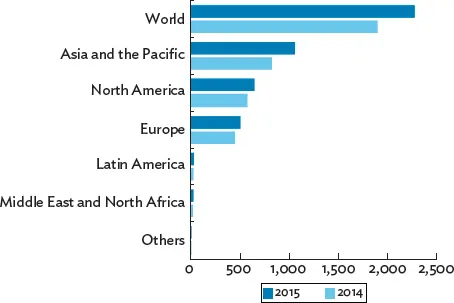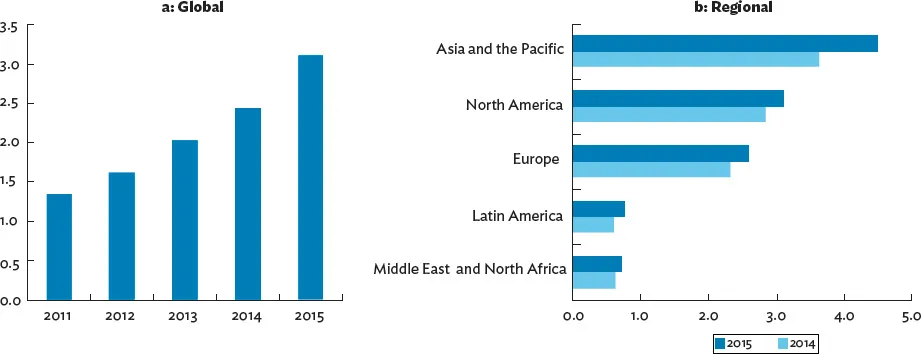![]()
1
E-commerce Evolution in Asia and the Pacific
Introduction
Buying and selling over digital networks has grown rapidly and will continue to do so, particularly across Asia and the Pacific. Electronic commerce, better known as e-commerce, offers many benefits. It creates greater competition, both within and across countries. It also allows greater inclusiveness in economic activity and boosts trade. However, it must deal with the many challenges that go beyond traditional commerce. These include building sufficient information and communication technology (ICT) infrastructure, enhancing digital literacy, legislating consumer and other legal protections, and enforcing cybersecurity, among others.
Major e-commerce categories include business-to-business (B2B), business-to-consumer (B2C), consumer-to-consumer (C2C), and business-to-government (B2G) transactions.
This report mainly focuses on B2C transactions. Even though B2B e-commerce is by far the largest in market turnover—almost 10 times the size of B2C in 2015—B2C is better discussed holistically, considering the entire e-commerce ecosystem of hardware and software infrastructure, legal issues (including those covering privacy and consumer protection), e-payment options, and delivery services, including the last mile ones.
Whereas the report mostly refers to B2C e-commerce, it also discusses various subsets, such as internet retail and mobile commerce (m-commerce), depending on available data or a specific segment that deserves special attention. Box 1.1 defines e-commerce as used in this report and lists data sources on B2C and internet retailing transactions.
Box 1.1: Definitions and Coverage of E-commerce
The definitions and sources of e-commerce data used in the report are illustrated in the box figure, and described below and in the box table:
E-commerce: This report uses the Organisation for Economic Co-operation and Development (OECD 2011) definition of e-commerce—also used by the United Nations Conference on Trade and Development (UNCTAD 2017a). E-commerce involves the purchase and sale of products (such as physical goods, digital products or services) transacted over computer networks. Technologies such as internet and electronic data interchange over devices such as personal computers, tablets, and mobile phones can be used for such purposes. Major e-commerce categories include business-to-consumer (B2C), business-to-business (B2B), and consumer-to-consumer (C2C).
Internet retailing: A subset of B2C e-commerce, internet retailing does not include activities such as auctions or travel reservations (Francis and White 2004).
Mobile commerce: E-commerce activities conducted through wireless handheld devices such as mobile telephones and personal digital assistants.
Breakdown of E-commerce into Internet Retail
B2B = business-to-business, B2C = business-to-consumer, B2G = business-to-government, C2C = consumer-to-consumer, UNCTAD = United Nations Conference on Trade and Development.
Sources: Ecommerce Foundation (2016a), eMarketer (2017), Euromonitor International (2018), and UNCTAD (2015, 2017a).
E-commerce Data Sources and Coverage
| Source | Coverage |
| UNCTAD | • Compiles data from multiple government sources of UN members, among others • B2C covers sales by “pure play” e-commerce enterprises to consumers and traditional brick-and-mortar retail or manufacturing firms that possess an online sales channel; covers both physical and digital products • Excludes transactions between businesses (B2B); private individuals (C2C); businesses and governments (B2G); and orders made by telephone, facsimile, manually typed e-mail |
| Ecommerce Foundation | • Compiles data from multiple government and private agencies, trade associations, etc. • B2C covers any B2C contract for the sale of goods and/or services, fully or partially concluded by a technique for distance communication • Excludes (i) C2C and B2B; (ii) online gambling and gaming; (iii) cars and other motor vehicles; (iv) houses and real estate; (v) utilities (e.g. water, heating, and electricity); (vi) mortgages, loans, credit cards, and overdrafts; and (vii) savings accounts, funds, stocks and shares, and bonds |
| eMarketer | • Compiles data from multiple government and private agencies, trade associations, etc. • Retail e-commerce includes products and services except travel, restaurant, and event ticket sales ordered over the internet using any device |
| Euromonitor International | • Compiles data from multiple government and private agencies, trade associations, etc. • Retail e-commerce includes orders placed over the internet for which payment is then made through a store card, an online credit account subsequent to delivery or on delivery of the product. Also includes mobile retailing and digital music and movie downloads. • Excludes (i) products generated over C2C sales websites, such as eBay (all sales over such websites are excluded, even if generated by companies operating through the website); (ii) sales of motor vehicles, motorcycles, and vehicle parts; (iii) tickets for events (sports, music concerts, etc.) and travel; (iv) sales of holiday packages; (v) revenue generated by online gambling sites; (vi) quick delivery services of food, magazines, household goods, and DVD rentals; and (vii) sales of wallpapers and ringtones. |
B2B = business-to-business, B2C =business-to-consumer, B2G = business-to-government, C2C = consumer-to-consumer, UN = United Nations, UNCTAD = United Nations Conference on Trade and Development.
Sources: Ecommerce Foundation (2016a), eMarketer (2017), Euromonitor International (2018), and UNCTAD (2015).
Source: ADB based on Ecommerce Foundation (2016a), eMarketer (2017), Euromonitor International (2018), Francis and White (2004), Gartner. M-commerce. https://www.gartner.com/it-glossary/m-commerce-mobile-commerce (accessed 28 April 2018), and UNCTAD (2015, 2017a).
Objectives, Scope, and Methodology of the Report
This report aims to answer an important policy question. How can the e-commerce industry and market be developed and grown to deliver positive social and economic outcomes in Asia and the Pacific? This report will:
(i)identify, document, evaluate, and provide an authoritative and up-to-date account of B2C e-commerce in the region;
(ii)develop a conceptual framework to study B2C e-commerce across the region;
(iii)identify and assess barriers organizations and consumers face when adopting e-commerce;
(iv)examine the macro-level impact of B2C e-commerce;
(v)evaluate how technological advances can help develop the e-commerce industry and market;
(vi)investigate ways to enhance inclusiveness in e-commerce development;
(vii)provide in-depth case studies from selected economies in Asia and the Pacific across the development spectrum to look for any development trends and patterns of the e-commerce industry and market—to better understand its facilitators and barriers; and
(viii)suggest options for key stakeholders such as businesses, governments, international organizations, trade associations, and consumers.
While the scope of this report is primarily B2C e-commerce, internet retail data are also used (subject to data availability) to supplement the discussions. We limit our focus to Asia and Pacific economies, although other regional and national economies are discussed for the purpose of comparison and benchmarking.
Given the limited availability of official e-commerce data, the research here is based mostly on secondary data and information. Quantitative as well as qualitative data are gathered from multiple sources (Appendix A presents the methodology used in greater detail).
Overview
Asia and the Pacific is a major driver of expansion in global B2C e-commerce.
The Asia and Pacific region holds the largest share of the B2C e-commerce market (Figure 1.1). According to the Netherlands-based Ecommerce Foundation, the region accounted for over $1 trillion of the $2.3 trillion global e-commerce total in 2015. North America had the second-largest share, with turnover at around $644 billion. Asia and the Pacific also had the fastest e-commerce growth in 2015—28% (the same as Latin America)—compared with the global growth rate of 20% (Ecommerce Foundation 2016a).
Figure 1.1: Size of Business-to-Consumer E-commerce by Region ($ billion)
Notes: Business-to-Consumer (B2C) e-commerce covers any contract for the sale of goods and/or services, fully or partially concluded by a technique for distance communication. Values refer to the total of goods and services sold through B2C transactions.
Source: Ecommerce Foundation (2016a).
E-commerce is clearly growing in economic activities (Figure 1.2). The share of e-commerce in global gross domestic product (GDP) rose from 1.3% in 2011 to 3.1% in 2015. Its contribution to the economy is most prominent in the Asia and Pacific region.
Figure 1.2: Size of Business-to-Consumer E-commerce (% of GDP)
GDP = gross domestic product.
Notes: Business-to-Consumer (B2C) e-commerce covers any contract for the sale of goods and/or services, fully or partially concluded by a technique for distance communication. Values refer to the total of goods and services sold through B2C transactions as a percentage of GDP.
Source: Ecommerce Foundation (2016a).
By the end of 2015, the size of e-commerce relative to GDP was 4.5% in Asia and the Pacific—the highest among regions globally. In comparison, the share of e-commerce in regional GDP stood at 3.1% and 2.6% in North America and Europe, respectively. E-commerce held even lower shares in Latin America (0.8% of regional GDP) and the Middle East and North Africa (0.7%).
Asia and the Pacific also does well in terms of the market size of internet retailing, a subset of B2C e-commerce (Figure 1.3). In 2017, the combined internet retailing market share of Asia and the Pacific was already above that of North America and Europe combined. According to Euromonitor International, the global internet retailing market share of Asia and th...



